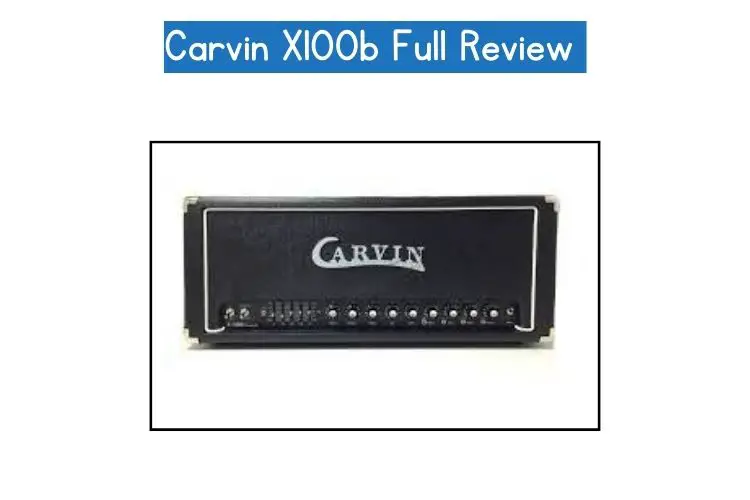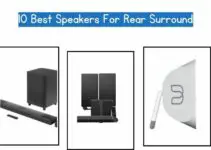It is a fact that far back in the 1980s, Carvin amps and guitars dominated the guitar world. They were on the pages of every guitar magazine and music publication. They were massive adverts telling people to buy Carvin amps and instruments.
The fact that they also made quite some amazing amps and instruments fueled their popularity. As a matter of fact, Carvin amps and instruments were generally loved and respected because of their superior level of craftsmanship and attention to detail on every amp and gear.
They did not only look amazing; they also sounded quite amazing and were favourites to some notable heavy weigh guitar players like Frank Zappa, Yngwie Malmsteen, Jaco Pastorius, and Steve Vai.
It is even alleged that Steve Vai recorded the track “Blue Powder” with Carvin X-100B, which is the amp we are discussing in this article. Although Carvin discontinued the X100B line for several years, its legacy still lived on as one of the best guitar amps to be made by Carvin.
However, because of its evergreen legacy and unending fame, Carvin has recently reintroduced both the head and 2×12 combo versions of the popular X100B. These newer models are merely attempts to capture the actual magic of the originals (although with some slight modifications).
Unarguably, the X100B was an amazing guitar amp and was well-sought-after back in the day. As a matter of fact, it is still highly sought-after today even in the vintage market. Getting your hands on one today is like getting your hands on a treasure.
Table of Contents
Carvin X100B — Features/Specs
- 100 watts output power
- Power soak feature, 50 and 25 watts
- Impedance selection for 16, 8, and 6 ohms
- Three 12AX7 preamp tubes
- Option to choose between EL34, 6L6, and 5881 power amp tubes
- Four power amp tubes
- XLR output jack
- FX loop with additional +4dB and -10dB modes
- Two channels
- 5-band graphic EQ, assignable to either of the channels
- Onboard reverb
Review of the Carvin X100B
Carvin’s X100B is not an amp that you’ll get the chance to see or hear that often. There are also some mixed opinions on it online. However, this is a somewhat specific model, and it’s more than effective if you know how to use it.
One of the biggest advantages of this two-channel amp is that it comes with the option to use either 6L6, EL34, or 5881 power amp tubes. This adds some further tone-shaping options that you usually don’t find with guitar amps most of the time.
But overall, looking at all of its specs, Carvin X100B is one of the most versatile amps that you can find. This is a double-edged sword. While it’s incredibly useful to have more tone-shaping options, it could either get too distracting, confusing, or just annoying to some players.
This is, of course, down to one’s personal preference. But it’s definitely not an amp for those who prefer a more straightforward approach to tone-shaping.
If you, however, like messing around with different tone-shaping options, there’s a lot to love with X100B. Apart from the 3-band EQ and presence control, there’s also a 5-band graphic equaliser.
This one can be assigned to either the amp’s clean or distorted channels but not both. Nonetheless, this allows for creating a contrast of sorts between the two channels. The amplifier’s character somewhat reminds us of the old Mesa Boogie amps.
It’s mostly “flat” in its response with a slight “scooped” twist. There’s a lot of headroom, especially with 6L6 tubes which allow for pristine clean tones with no “dirt” on them. But on high-gain settings, you can notice more of a Marshall-like flavour.
What’s also really great is that its bright switches won’t make your ears bleed but just add a slight boost to the top end. And that’s what can generally be said about this amp. It’s incredibly balanced and yet allows for some variety in tone shaping.
Carvin X100B — What Makes It So Special?
Two things make this amp really stand out. Firstly, its controls make it way more versatile than most of its contemporaries back in the 1980s. The tube-swapping option was also something you’d not see that often with most amplifiers.
And, apart from the abundance of controls on the front panel, you also get an XLR output that allows you to go directly into a PA. And secondly, it’s not that expensive if you manage to find one.
In fact, it’s incredibly inexpensive for a vintage tube-driven amp. At this point, you could find a half-stack for under $1,000. There were also combo versions with two 12-inch speakers, although they’re rare. And these are even cheaper.
Brief History of the Carvin X100B
Carvin originally introduced the X100B head back in 1982. Although not massively popular, the amp had some following. Even some of the biggest names in the world of guitar used it, including Steve Vai.
The amp went through some design changes over the coming years. There were even combo versions. However, Carvin eventually discontinued the amp in 1994. They re-launched it in 2008 with some technical changes that were more practical for that era.
However, the company Carvin Audio eventually closed its factory in 2017. It’s not easily traceable when exactly the revamped X100B was abandoned, but it’s probably around this time.
The company relaunched its website and operation in 2018, but they’re outsourcing their manufacturing overseas.
The Carvin Legacy
Although discontinued for a while now, Carvin X100B still has the attention of guitar players. It’s not exactly obscure, but you’ll also not hear about it very often. But those who have tried it either love it or hate it. There’s rarely ever anything in between.
As for the company, Carvin remains one of the most respected names in the business. Although, at this moment, the company Carvin Audio is no longer operating in the same capacity, they still offer some interesting guitar-related products, including pedals, amplifiers, and even one 100-watt power amp in the form of a stompbox called Mach 100.
Then there’s also a tube-driven preamp pedal called the X-1, a V-112 extension cabinet, and an acoustic guitar preamp called Koa. Today, they’re mostly focused on PA systems.
As for their old amplifiers, Carvin had so many incredible pieces. The most famous could easily be the Legacy guitar amp which was a Steve Vai signature series. There were also Frank Zappa, Yngwie Malmsteen, Frank Gambale, Dweezil Zappa, John Frusciante, and Vinnie Vincent, just to name a few.
Apart from amps and pedals, Carvin also made guitars. This division of the company would split from the company in 2015 and become known as Kiesel. The old Carvin guitars were used by the likes of Jason Becker, Joe Walsh, Jerry Horton, Marty Friedman, Allan Holdsworth, and many others.
Where are Carvin Amps Made?
Carvin as a brand still exists, although it’s not the same company as it originally was. For many decades, Carvin made their amplifiers, as well as guitars and other gear, in San Diego, California.
There were also brief periods in the late 1940s when their production moved to other parts of the country, although it’s highly unlikely that you’ll find something from these eras.
Today, whatever they’re selling, is manufactured overseas. The factory in San Diego, California, was closed back in 2017 and the company has a completely different model of operation at the moment.
Famous Players Who Use(d) the Carvin X100B
- Steve Vai
- Frank Zappa
- Dweezil Zappa
- Yngwie Malmsteen
- John Frusciante
- Jason Becker
- Vinnie Vincent
- Craig Chaquico
- Erik Turner
- Joe Allen
- Daron Malakian
What Should You Look for in an Amp?
Before we get to any details, there’s one thing that we need to clear up first. There’s no such thing as the perfect guitar amp. You won’t be able to get that one amp that will serve you well in any genre.
With that said, what you should look for in an amp depends primarily on what you want to achieve. Along with that, there’s also the budget that you have, as well as what you’re planning to do with the amp, whether it is live gigs, playing at home, or a combination of both.
Of course, the choice between tube-driven vs. solid-state is still as relevant as it ever was. Tube amps might be more expensive, but they’re still the best option if you need some dynamic response and warmth in your tone.
On the other hand, solid-state amps have been getting much better lately and can get pretty close these days. The style of music and some personal preferences are important.
If you need a thick heavy tone for metal music, look into some modern high-gain amps with an abundance of tone-shaping features. If you’re looking for something old-school-oriented, a simple tube-driven amp with lower wattage will be a better choice.
As far as Carvin X100B goes, it’s a high-gain amp with an abundance of features. It covers a lot of territories, although its character tends to be a bit “scooped” compared to the average.
Its biggest advantage is versatility, as well as its relatively low price. However, a big downside is that you can’t really find them easily, and it’s not always certain how reliable they’ll be.
Carvin X100B Serial Numbers
Although not exactly obscure, Carvin’s X100B amps are somewhat rare. And due to the company being completely changed, there are not a lot of things about them readily available online.
If you’re interested in serial numbers and years of production, this is pretty difficult to trace. There’s not a lot of info readily available online about them.
Conclusion
Carvin X100B is one of the rare great tube-driven amp models that’s not that expensive. The opinions on it are a bit divisive.
But, objectively, this is a pretty great amplifier. If you plan on getting one of these, the old ones from the initial production series are probably a better choice. Just make sure that what you’re getting is in good condition.




![10 BEST DAWs for Film Scoring [Buying Guide + Pros & Cons]](https://performerlife.com/wp-content/uploads/2023/05/10-Best-DAWs-for-Film-Scoring-1-211x150.jpg)
